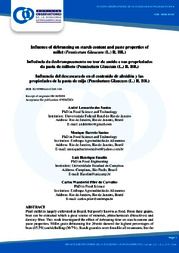Influence of debranning on starch content and paste properties of millet (Pennisetum Glaucum (L.) R. BR.).
Influence of debranning on starch content and paste properties of millet (Pennisetum Glaucum (L.) R. BR.).
Author(s): SANTOS, A. L. dos; SANTOS, M. B.; FASOLIN, L. H.; CARVALHO, C. W. P. de
Summary: Pearl millet is largely cultivated in Brazil, but poorly known as food. From their grains, bran can be extracted which a great source of minerals, phitochemicals (bioactives) and dietraty fiber. This work investigated the effect of debraning time on starch content and paste properties. Millet grain debranning for 20 min showed the highest percentages of bran (15.5%) and dehulling (30.7%). Starch granules were found in all treatments, but the lowest content was found after 5 min debranning (7.23%). As expected, all brans obtained at varied debranning time did not show any peak viscosity as the amount of starch did not account for the viscosity along with the insoluble fibers that are known for not increase viscosity under heat in excess of water.
Publication year: 2024
Types of publication: Journal article
Unit: Embrapa Food Technology
Observation
Some of Embrapa's publications are published as ePub files. To read them, use or download one of the following free software options to your computer or mobile device. Android: Google Play Books; IOS: iBooks; Windows and Linux: Calibre.
Access other publications
Access the Agricultural Research Database (BDPA) to consult Embrapa's full library collection and records.
Visit Embrapa Bookstore to purchase books and other publications sold by Embrapa.

